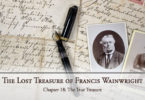It was easy to figure out that the American Revolution was in full swing by the time Philippa’s statue disappeared from the old cemetery maps. There were several possible reasons for its disappearance, but only two stood out as the most likely. Either the statue was requisitioned by the town of Ipswich to be melted down for materials needed for the war, such as bullets and cannon balls, or the statue was moved to a place where it would be protected from damage by gunfire.
The Revolution took place during the generation where Francis and Philippa’s great-grandchildren would have been adults, may be fighting in the war, and probably with children of their own. It was far enough away from Francis and Philippa’s time that some of the descendants may not have known or cared about the family history and the significance of the statue, particularly on the female lines where last names would have changed. However, it wasn’t so far away from the happy couple that everyone in their line would have forgotten about them. It was entirely likely that at least some Wainwrights… those who still bore the last name… knew about Francis and Philippa’s epic love story and the significance of the statue. That statue was part of their family heritage. It seemed plausible that at least a few family members would want to protect it.
With some ancient headstones in the Old Burying Ground bearing chips and marks from musket fire during both the Revolution and the Civil War, a statue as large and prominent as Philippa’s would have been a perfect target for anyone hoping to hurt the family. Its sheer size and noticeability made it more likely to be hit by a bullet or cannon than the smaller headstones.
And, unless there was a real shortage of materials for munitions in Ipswich (or a hardship in acquiring them) during the Revolution, the town was unlikely to requisition private family property from a cemetery. The Puritan religion may not have dominated the area by the time of the Revolution, but most soldiers and their wives would have remembered staunchly Puritan grandparents… enough so that they would think very carefully before removing material from hallowed ground.
None of the Willick grandchildren recalled hearing about any particular hardship in the area that would warrant such desecration, so the most likely option was that the statue was moved to protect it.
But, to where?
“Well, the most likely choice would be inside the tomb,” Christine said, albeit reluctantly. None of them really wanted to go in there, even if they could figure out how (and, assuming it was legal).
Who knew how long it had been since that door was opened? God knew what they would find in there. Plenty of things they didn’t want to locate, that’s for sure. And, what if the statue wasn’t there? What then? Where could they possibly continue looking for it?
It’s not like a descendant was going to be keeping something like that in their attic or back yard, and Christine, Grace, and Emily had all been to every museum in Essex County numerous times; there were no life-sized statues of anyone in them, at least not ones made during the lifetimes of their subjects or anyone who would have known them personally.
The others nodded, with similar reluctance, agreeing. The tomb made sense. It was the perfect place to protect the statue.
“We’re just going to have to give it a try,” Grace concluded, deciding for everyone. “We’ve come this far. We need to see it through. Besides, we owe it to Grandma, and all the generations who came before her who searched for the treasure and didn’t find it.”
“And, if it’s not in the tomb?” Adam asked.
“We start looking through town records from the Revolutionary War, to find out if it was requisitioned,” Emily stated.
“You can’t hide something that big and expensive from the records,” James agreed. “There has to be some record somewhere of what became of it. We’ll find it. It may take a while, with all the research, but if it isn’t in the tomb, we will find it.”
“Assuming we can get into the tomb,” Christine reminded them.
There was no better way to find out the legalities of entering a tomb in the Old Burying Ground than asking, which is exactly what Christine did. The old woman behind the counter looked surprised and admitted in her forty years of working at the town hall, no one had ever asked to enter one of the ancient tombs. She would have to research it and asked the cousins to wait.
It took a while. Clearly, everyone in the building was working on finding the answer at one point. After about half an hour, the old woman reappeared, thanked them for their patience, and gave them their answer.
“Families usually have the keys, handed down through the generations,” the woman said. “Obviously, these are very old tombs, and no one has entered most of them in more than a century, so we can’t expect every family to have retained their keys. Not every generation is interested in that sort of thing, after all, especially newer ones who don’t anticipate ever using the keys. They get thrown away and lost. Fortunately, we do have backups here, which I did not know. No one did, actually. One of my co-workers did the research and found out we keep them in a vault in the basement.”
“Can we get the Wainwright key?” Grace asked.
The woman nodded. “If you can prove your descent, yes. A city worker will also have to accompany you, as we don’t want any grave robbing or vandalism going on….not that I think any of you would do that,” she was quick to add. “Fortunately, I am not busy, and there are others who can fill in for me for an hour or two, so I volunteered to go. All I need is to see your proven descent.”
Christine had that on her, in her laptop case. Once the woman went over it, she nodded, disappeared again, and came back holding a large, rusty iron key, the kind you see in old movies or cartoons. It looked strangely appropriate for what they were about to do.
“Well,” Emily said, shrugging and giving a wary half-laugh. “Anyone up for a round of Tomb Raider?”
Next: Chapter 17 — What Was in the Wainwright Tomb





